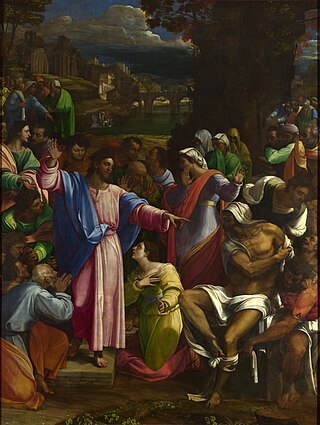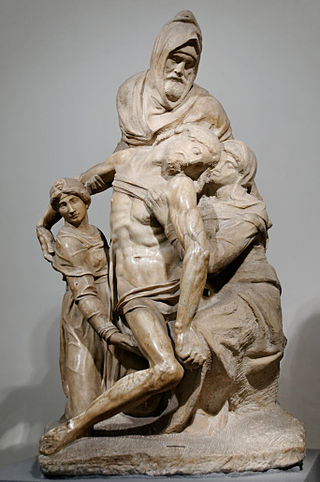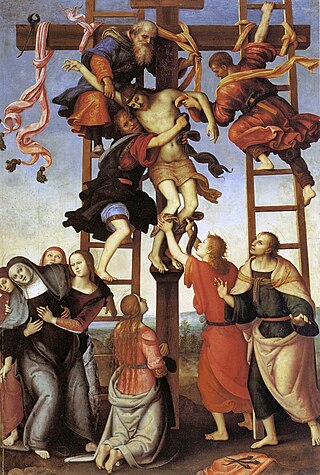
Raffaello Sanzio da Urbino, now generally known in English as Raphael, was an Italian painter and architect of the High Renaissance. His work is admired for its clarity of form, ease of composition, and visual achievement of the Neoplatonic ideal of human grandeur. Together with Leonardo da Vinci and Michelangelo, he forms the traditional trinity of great masters of that period.

Luca Signorelli was an Italian Renaissance painter from Cortona, in Tuscany, who was noted in particular for his ability as a draftsman and his use of foreshortening. His massive frescos of the Last Judgment (1499–1503) in Orvieto Cathedral are considered his masterpiece.

Pinturicchio, or Pintoricchio, also known as Benetto di Biagio or Sordicchio, was an Italian Renaissance painter. He acquired his nickname because of his small stature and he used it to sign some of his artworks that were created during the fifteenth and sixteenth centuries.

Pietro Perugino, an Italian Renaissance painter of the Umbrian school, developed some of the qualities that found classic expression in the High Renaissance. Raphael became his most famous pupil.

Sebastiano del Piombo was an Italian painter of the High Renaissance and early Mannerist periods, famous as the only major artist of the period to combine the colouring of the Venetian school in which he was trained with the monumental forms of the Roman school. He belongs both to the painting school of his native city, Venice, where he made significant contributions before he left for Rome in 1511, and that of Rome, where he stayed for the rest of his life, and whose style he thoroughly adopted.

Caravaggio created one of his most admired altarpieces, The Entombment of Christ, in 1603–1604 for the second chapel on the right in Santa Maria in Vallicella, a church built for the Oratory of Saint Philip Neri. A copy of the painting is now in the chapel, and the original is in the Vatican Pinacoteca. The painting has been copied by artists as diverse as Rubens, Fragonard, Géricault and Cézanne.

The Raising of Lazarus is a large altarpiece of 1517–1519 by the Italian High Renaissance artist Sebastiano del Piombo, for which Michelangelo supplied drawings for some figures. Intended for Narbonne Cathedral in France, it is now normally in Room 18 of the National Gallery in London, where it is "NG1", the first painting catalogued at the founding of the gallery in 1824.

The Deposition is a marble sculpture by the Italian High Renaissance master Michelangelo. The sculpture, on which Michelangelo worked between 1547 and 1555, depicts four figures: the dead body of Jesus Christ, newly taken down from the Cross, Nicodemus, Mary Magdalene and the Virgin Mary. The sculpture is housed in the Museo dell'Opera del Duomo in Florence and is therefore also known as the Florentine Pietà.

The Oddi Altarpiece, or more correctly the degli Oddi altarpiece, is an altarpiece of the Coronation of the Virgin painted in 1502-1504 by the Italian Renaissance master Raphael for the altar of the Oddi family chapel in the church of San Francesco al Prato in Perugia, Italy, now in the Vatican Pinacoteca. The altarpiece was commissioned for the Oddi family chapel in San Francesco al Prato in Perugia, was taken to Paris in 1797 and in 1815 brought back to Italy, not to Perugia but to the Vatican Pinacoteca.

The Mond Crucifixion or Gavari Altarpiece is an oil on poplar panel dated to 1502–1503, making it one of the earliest works by Italian Renaissance artist Raphael, perhaps the second after the c.1499-1500 Baronci Altarpiece. It originally comprised four elements, of which three survive, now all separated: a main panel of the Crucified Christ with the Virgin Mary, Saints and Angels which was bequeathed to the National Gallery, London, by Ludwig Mond, and a three-panel predella from which one panel is lost; the two surviving panels are Eusebius of Cremona raising Three Men from the Dead with Saint Jerome's Cloak in the Museu Nacional de Arte Antiga, in Lisbon, and Saint Jerome saving Silvanus and punishing the Heretic Sabinianus in the North Carolina Museum of Art.

The Entombment is an unfinished oil-on-panel painting of the burial of Jesus, now generally attributed to the Italian Renaissance master Michelangelo Buonarroti and dated to around 1500 or 1501. It is in the National Gallery in London, which purchased the work in 1868 from Robert Macpherson, a Scottish photographer resident in Rome, who, according to various conflicting accounts, had acquired the painting there some 20 years earlier. It is one of a handful of paintings attributed to Michelangelo, alongside the Manchester Madonna, the Doni Tondo, and possibly, The Torment of Saint Anthony.

The Annunziata Polyptych is a painting cycle started by Filippino Lippi and finished by Pietro Perugino, whose central panel is now divided between the Galleria dell'Accademia and the Basilica dell'Annunziata, both in Florence, Italy. The polyptych had other six panels, which are housed in the Lindenau-Museum of Altenburg, the Metropolitan Museum of New York City, the Galleria Nazionale d'Arte Antica in Rome and in a private collection in South Africa.

The Vallombrosa Altarpiece is a painting by the Italian Renaissance painter Pietro Perugino, dating to 1500–01. It is housed in the Accademia Gallery of Florence, Italy.
The Entombment usually refers to the entombment, or burial, of Jesus.

The Lamentation of Christ is an oil-on-panel painting of the common subject of the Lamentation of Christ by the Netherlandish artist Rogier van der Weyden, dating from around 1460–1463 and now in the Uffizi Gallery, Florence, Italy.

The San Pietro Polyptych is a polyptych by Italian Renaissance master Perugino, painted around 1496–1500. The panels are now in different locations: the lunette and the central panel, depicting the Ascension of Christ, are in the Museum of Fine Arts of Lyon, France.

The Lamentation of Christ is an oil on canvas painting by the Italian Renaissance artist Correggio, dating from around 1524 and housed in the Galleria Nazionale of Parma, Italy.

The Sant'Agostino Altarpiece is a painting by Perugino, produced in two stages between around 1502 and 1512 and then around 1513 to 1523. The altarpiece's 28, 29 or 30 panels were split up during the Napoleonic suppression of religious houses - most of its panels are now in the Galleria Nazionale dell'Umbria in Perugia. It is notable as the painter's last masterwork before he moved into his late phase producing more provincial commissions.

The Santa Maria dei Fossi Altarpiece is a 1496-1498 painting by Pinturicchio, now in the Galleria nazionale dell'Umbria in Perugia. Unusually for an altarpiece, it is painted on canvas stretched over wooden panels.

The Entombment of Christ is a 1513–1516 oil-on-canvas painting by the Italian Renaissance artist Lorenzo Lotto, now in the Accademia Carrara in Bergamo. It originally formed the central predella panel to the artist's Martinengo Altarpiece at the church of Santi Bartolomeo e Stefano.























